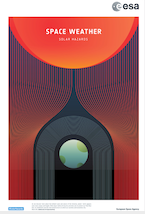Speaker
Description
Science class space radiation spectrometers are embarked on satellites to collect data for various objectives including validation / improvement / development of radiation environment models, characterization of the dynamics of the space radiation environment as well as provide space weather services.
The EPT is actually flying on-board PROBA-V as technology demonstration payload. The operational principle of the EPT (predominantly a range telescope) leads to an instrument with an excellent in-flight particle discrimination capability and immunity to contamination by off-Field of View particles. It provides flux spectra of electrons (0.5–8 MeV), protons (9.5–300 MeV) and α-particles (38–1200 MeV). The measurements are conducted continuously with 2 s time resolution and transmitted on-ground 3 times per day, where within several hours they are processed till high-level scientific data products, that are then available at the ESA SSA-SWE portal (SSA Space Weather, Expert Service Center Space Radiation).
Now that the concept has been demonstrated to lead to the expected performances, it was decided to develop a miniaturized version of the instrument. The objective of the miniaturised EPT (mEPT) development is to produce a compacter radiation telescope of size ~200 cm3, but whose performances in particle detection are comparable to that of the EPT. The targeted power consumption of the device is ~1 W which should be achieved by use of adapted integrated circuit (IC) technology, among others.
The 3D Energetic Electron Spectrometer (3DEES), that is actually under development (TRL 4), is a compact and modular electron spectrometer designed on the basis of an innovative concept that allows angle resolved high energy coverage for electrons (0.1 – 10 MeV ) using few sensors. Its basic configuration provides capabilities to measure angular distribution of electrons and protons at 12 angles spanning over 180° in two planes. The 3DEES concept also allows measurements of proton fluxes (4-50 MeV), while performing absolute electron-proton discrimination for protons up to 200 MeV. Although designed as instrument to deliver data for detailed scientific studies, its data can find direct application within Space Weather services, in the same way than EPT.
This presentation will give a general review of three instruments wherein the main assets and achievements of the EPT will be briefly revisited and an introduction to the miniaturized instrument and its key features will be presented. The 3DEES in its latest status will also be presented together with its performances that are expected to be attained.

